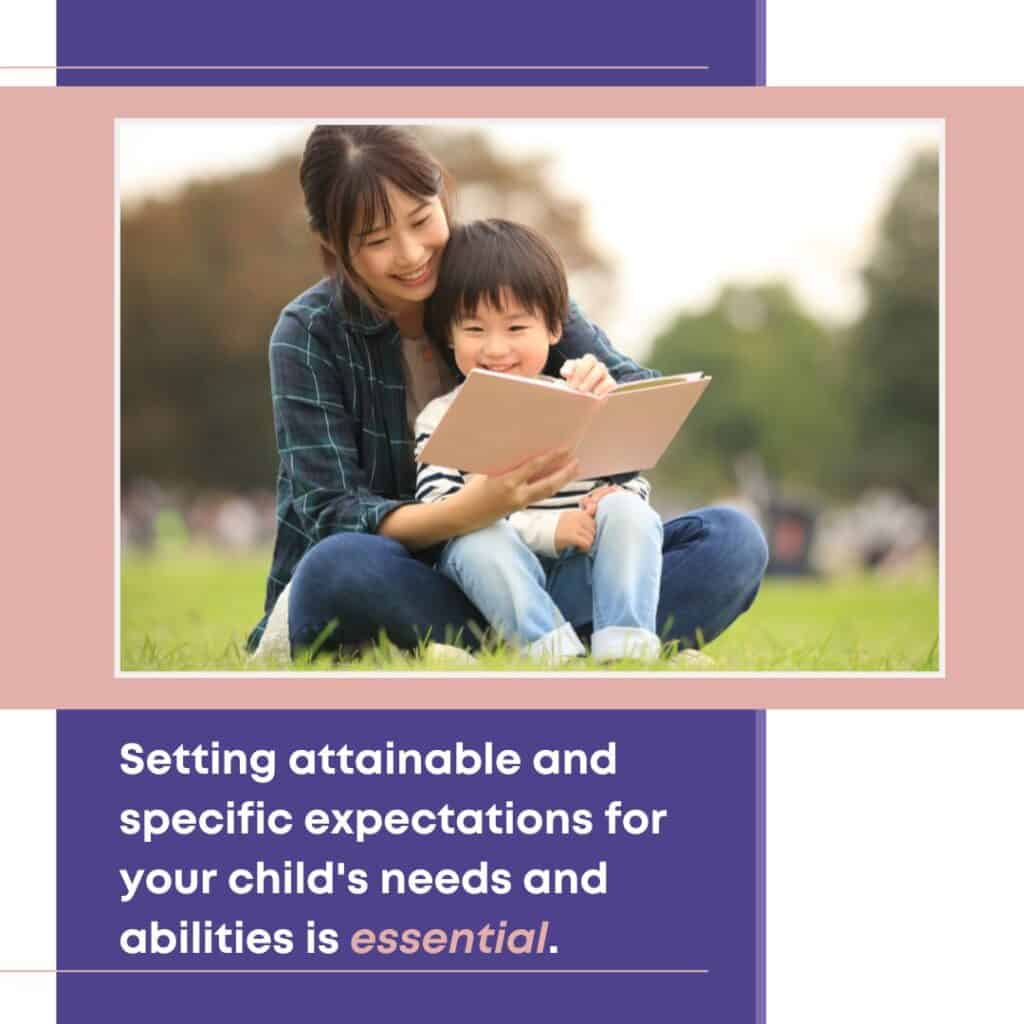Expectations, we all have them! Most of us have high expectations or preferred futures we desire our kids to experience. We know what the result should be, but not necessarily the steps to get there! And sometimes, let’s be honest, when trauma and the world we live in collide, things aren’t as they appear. When our expectations aren’t realistic, we get stuck, give up, and get frustrated. Maybe that’s you, but remember, you’re not alone in your journey toward creating healthy expectations.
We all set expectations with good intentions. We all want our kiddos to grow, achieve, be productive, and be the best version of themselves. However, our pride, lack of education on lagging skills, or how to identify our child’s strengths and weaknesses can hinder us. If that’s you, remember, help is just a step away! For instance, a realistic expectation for a child from a hard place might be to improve their social skills by joining a club or group activity rather than expecting them to become the most popular kid in school overnight.
Another example could be celebrating small victories, such as completing homework on time or making a new friend, rather than expecting them to achieve straight A’s. This practice acknowledges their efforts, boosts their confidence, and motivates them to continue. Setting attainable and specific expectations for the child’s needs and abilities is essential. Remember, every step forward is worth celebrating!

Creating Healthy Expectations
When setting expectations, there are a few helpful things to remember.
1. Children Grow and Develop at Different Paces and Stages.
The developmental milestone chart (a tool that outlines the typical age at which children reach specific developmental stages) shows milestones arranged several months apart. Look at your child as an individual! Setting attainable and particular expectations for the child’s needs and abilities is essential. Understand that they are unique and different from their siblings and their peers. Comparison is a thief! A child’s progress is an individual sport—treating it that way and considering their strengths and weaknesses is essential.
If your child is exhibiting challenging behavior, such as tantrums or aggression, it is necessary to give them the tools to handle their frustrations more self-regulated. For example, you could set the healthy expectation that instead of hitting or yelling when upset, they need to use their words to express themselves and help them feel more in control. Remember that self-regulation is a skill that takes time and practice to develop. By providing your child with tools and resources to help them self-regulate, you are helping them build a strong foundation for their emotional and behavioral well-being.
Using the Engine
One self-regulation tool that one can use is “Using the Engine.” This tool allows children to understand and regulate their alertness and energy levels by comparing their bodies to a car engine. When the engine runs too fast, the child may feel anxious, irritable, or overwhelmed. When the engine runs too slow, the child may feel tired, sluggish, or bored. The goal is to help the child identify their feelings and provide them with strategies to bring their engine back to a “just right” level of alertness and energy.
Using this tool, you can create a visual aid that looks like a car dashboard. It should have three sections:
- A green “just right” section
- A red “too fast” section and
- A blue “too slow” section
You can represent each section with pictures or symbols.
Then, you can help the child identify what activities or situations make their engine run too fast or too slow. For example, watching an exciting movie might make their engine run too fast, while doing a quiet puzzle might make it run too slow.
Once the child can identify when their engine is too fast or too slow, you can provide strategies to regulate it. For example, if their engine is running too fast, they can take deep breaths, do some jumping jacks, or take a break to calm down. If their engine is running too slow, they can do some stretches, take a quick walk, or engage in a stimulating activity to increase their alertness.
Using the engine tool can help children become more aware of their bodies and emotions and develop strategies for regulating their behavior.

2. Be Their Biggest Cheerleader!
We must verbally express our expectations to our kids with the proper emotional connection and support. Connection is always the secret sauce! We cannot just verbally lay out our expectations—here is where it can become a team sport. As parents, we have the power to guide and encourage our children and create healthy expectations together. By sharing our experiences and connecting with their feelings, we can help them feel supported and understood. For instance, you could share your struggle with math growing up, how it was hard to make friends, and how you overcame those struggles. Connect with their anxiousness, allowing them to share their feelings surrounding their fears and apprehensions. Your child will feel supported, understood, and heard when doing these things.
3. Create Immediate Achievements.
Immediate achievements can be a game-changer in your child’s development. They get your child into action faster and help them meet higher challenges sooner. Your child can build confidence and momentum by setting and conquering small goals. For instance, turning completing homework on time into a fun activity for a week can be a small goal. These immediate achievements not only build momentum but also instill a sense of confidence and accomplishment in your child, motivating them to tackle more significant challenges.
Suppose you are still determining where to start and where to set expectations. In that case, what is currently bringing the most frustration for your child and your home? Identifying the source of their or your frustration can help you to be more effective in your approach. Is your child having difficulty with a particular subject in school? Are they struggling to adjust to a new routine or environment? Is there a specific behavior causing tension at home or school? Once you identify the gaps in skills, you can move forward with finding a solution that benefits everyone.

Failing to create healthy, appropriate expectations for our kids can lead to frustration, disappointment, and resentment. It can also contribute to putting too much unnecessary pressure, setting them up for failure. Unrealistic expectations have the potential to lead to feelings of inadequacy and anxiety, making it difficult for them to thrive. Remember that childhood is not a race to the finish line but a journey with struggle and victories all along the way. We can be a part of their growth and development by setting attainable and specific expectations that match their unique differences and abilities. I can’t think of a more excellent gift as a parent!




















